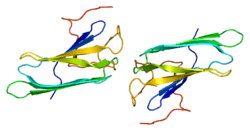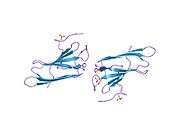PTGES3
Prostaglandin E synthase 3 (cytosolic) is an enzyme that in humans is encoded by the PTGES3 gene.[5]
The protein encoded by this gene is also known as p23 which functions as a chaperone which is required for proper functioning of the glucocorticoid and other steroid receptors.[6]
References
- 1 2 3 GRCh38: Ensembl release 89: ENSG00000110958 - Ensembl, May 2017
- 1 2 3 GRCm38: Ensembl release 89: ENSMUSG00000071072 - Ensembl, May 2017
- ↑ "Human PubMed Reference:".
- ↑ "Mouse PubMed Reference:".
- ↑ "Entrez Gene: PTGES3 Prostaglandin E synthase 3 (cytosolic)".
- ↑ Freeman BC, Yamamoto KR (June 2002). "Disassembly of transcriptional regulatory complexes by molecular chaperones". Science. 296 (5576): 2232–2235. doi:10.1126/science.1073051. PMID 12077419.
Further reading
- Johnson JL, Beito TG, Krco CJ, Toft DO (1994). "Characterization of a novel 23-kilodalton protein of inactive progesterone receptor complexes". Mol. Cell. Biol. 14 (3): 1956–63. PMC 358554. PMID 8114727.
- Wu T, Wu H, Wang J, Wang J (2011). "Expression and cellular localization of cyclooxygenases and prostaglandin E synthases in the hemorrhagic brain". J Neuroinflammation. 8: 22. doi:10.1186/1742-2094-8-22. PMC 3062590. PMID 21385433.
- Bonaldo MF, Lennon G, Soares MB (1997). "Normalization and subtraction: two approaches to facilitate gene discovery". Genome Res. 6 (9): 791–806. doi:10.1101/gr.6.9.791. PMID 8889548.
- Dittmar KD, Pratt WB (1997). "Folding of the glucocorticoid receptor by the reconstituted Hsp90-based chaperone machinery. The initial hsp90.p60.hsp70-dependent step is sufficient for creating the steroid binding conformation". J. Biol. Chem. 272 (20): 13047–13054. doi:10.1074/jbc.272.20.13047. PMID 9148915.
- Dittmar KD, Demady DR, Stancato LF, et al. (1997). "Folding of the glucocorticoid receptor by the heat shock protein (hsp) 90-based chaperone machinery. The role of p23 is to stabilize receptor.hsp90 heterocomplexes formed by hsp90.p60.hsp70". J. Biol. Chem. 272 (34): 21213–21220. doi:10.1074/jbc.272.34.21213. PMID 9261129.
- Zou J, Guo Y, Guettouche T, et al. (1998). "Repression of heat shock transcription factor HSF1 activation by HSP90 (HSP90 complex) that forms a stress-sensitive complex with HSF1". Cell. 94 (4): 471–480. doi:10.1016/S0092-8674(00)81588-3. PMID 9727490.
- Yoo JY, Hamburger AW (1999). "Interaction of the p23/p198 protein with ErbB-3". Gene. 229 (1–2): 215–221. doi:10.1016/S0378-1119(98)00604-0. PMID 10095121.
- Knoblauch R, Garabedian MJ (1999). "Role for Hsp90-associated cochaperone p23 in estrogen receptor signal transduction". Mol. Cell. Biol. 19 (5): 3748–59. PMC 84199. PMID 10207098.
- Muñoz MJ, Bejarano ER, Daga RR, Jimenez J (2000). "The identification of Wos2, a p23 homologue that interacts with Wee1 and Cdc2 in the mitotic control of fission yeasts". Genetics. 153 (4): 1561–72. PMC 1460861. PMID 10581266.
- Freeman BC, Felts SJ, Toft DO, Yamamoto KR (2000). "The p23 molecular chaperones act at a late step in intracellular receptor action to differentially affect ligand efficacies". Genes Dev. 14 (4): 422–34. PMC 316379. PMID 10691735.
- Weaver AJ, Sullivan WP, Felts SJ, et al. (2000). "Crystal structure and activity of human p23, a heat shock protein 90 co-chaperone". J. Biol. Chem. 275 (30): 23045–23052. doi:10.1074/jbc.M003410200. PMID 10811660.
- Tanioka T, Nakatani Y, Semmyo N, et al. (2000). "Molecular identification of cytosolic prostaglandin E2 synthase that is functionally coupled with cyclooxygenase-1 in immediate prostaglandin E2 biosynthesis". J. Biol. Chem. 275 (42): 32775–32782. doi:10.1074/jbc.M003504200. PMID 10922363.
- Kazlauskas A, Poellinger L, Pongratz I (2001). "The immunophilin-like protein XAP2 regulates ubiquitination and subcellular localization of the dioxin receptor". J. Biol. Chem. 275 (52): 41317–41324. doi:10.1074/jbc.M007765200. PMID 11013261.
- Futatsumori M, Kasai K, Takatsu H, et al. (2001). "Identification and characterization of novel isoforms of COP I subunits". J. Biochem. 128 (5): 793–801. doi:10.1093/oxfordjournals.jbchem.a022817. PMID 11056392.
- Kazlauskas A, Sundström S, Poellinger L, Pongratz I (2001). "The hsp90 chaperone complex regulates intracellular localization of the dioxin receptor". Mol. Cell. Biol. 21 (7): 2594–2607. doi:10.1128/MCB.21.7.2594-2607.2001. PMC 86890. PMID 11259606.
- Forsythe HL, Jarvis JL, Turner JW, et al. (2001). "Stable association of hsp90 and p23, but Not hsp70, with active human telomerase". J. Biol. Chem. 276 (19): 15571–15574. doi:10.1074/jbc.C100055200. PMID 11274138.
- Donzé O, Abbas-Terki T, Picard D (2001). "The Hsp90 chaperone complex is both a facilitator and a repressor of the dsRNA-dependent kinase PKR". EMBO J. 20 (14): 3771–3780. doi:10.1093/emboj/20.14.3771. PMC 125551. PMID 11447118.
- Elder RT, Yu M, Chen M, et al. (2001). "HIV-1 Vpr induces cell cycle G2 arrest in fission yeast (Schizosaccharomyces pombe) through a pathway involving regulatory and catalytic subunits of PP2A and acting on both Wee1 and Cdc25". Virology. 287 (2): 359–370. doi:10.1006/viro.2001.1007. PMID 11531413.
- Hernández MP, Chadli A, Toft DO (2002). "HSP40 binding is the first step in the HSP90 chaperoning pathway for the progesterone receptor". J. Biol. Chem. 277 (14): 11873–11881. doi:10.1074/jbc.M111445200. PMID 11809754.
- McLaughlin SH, Smith HW, Jackson SE (2002). "Stimulation of the weak ATPase activity of human hsp90 by a client protein". J. Mol. Biol. 315 (4): 787–798. doi:10.1006/jmbi.2001.5245. PMID 11812147.
- Cox MB, Miller CA (2002). "The p23 co-chaperone facilitates dioxin receptor signaling in a yeast model system". Toxicol. Lett. 129 (1–2): 13–21. doi:10.1016/S0378-4274(01)00465-9. PMID 11879970.
This article is issued from
Wikipedia.
The text is licensed under Creative Commons - Attribution - Sharealike.
Additional terms may apply for the media files.





